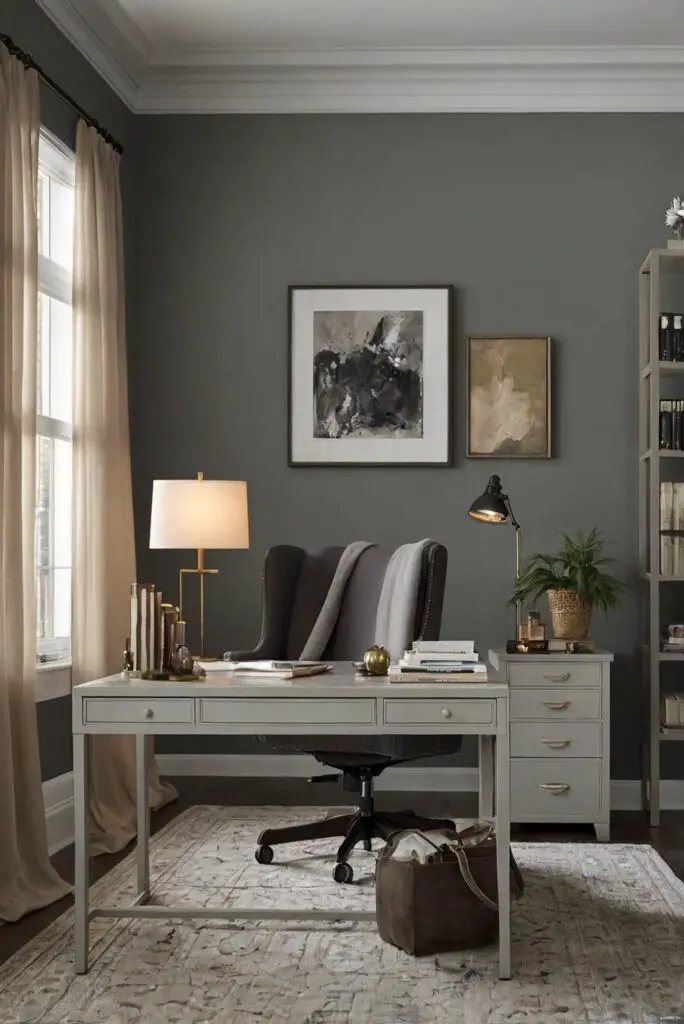Discover how the right color combinations can boost productivity in your home office. Find the perfect shades to enhance focus and creativity.
Using a color scheme that promotes productivity is essential for a home office. Neutral tones like white, beige, or light gray create a calming effect and enhance focus. Pairing these with accents of green or blue can stimulate creativity and reduce stress. Consider incorporating elements of natural wood for warmth and coziness. To maintain a well-organized space, opt for furniture that matches the color palette and provides ample storage solutions. Utilize proper lighting fixtures to illuminate the workspace effectively. By following these color combinations and design principles, your home office can be a productive and inspiring environment for work.
When creating a productive home office, selecting the right color combinations is crucial. Here are some popular color combinations that can enhance your workspace:
My Lovely Spring Paint for 2025
Ready for a Spring Makeover? Explore the Freshest 2025 Paint Trends!
White Sage/Green SW Pistachio green Soft blue Honeysweet/Orange Pink Sugar Sage Tint BMAs an Amazon Associate, I may earn a commission from qualifying purchases at no extra cost to you.
1. **Blue and White**: Blue is known for boosting productivity and concentration, while white offers a sense of cleanliness and spaciousness. This combination creates a calming and professional environment ideal for focused work.
2. **Green and Beige**: Green is associated with balance and harmony, while beige provides a neutral backdrop. This pairing brings a touch of nature indoors, promoting a sense of tranquility and connection to the environment.
3. **Gray and Yellow**: Gray conveys a sense of sophistication and stability, while yellow adds a pop of energy and creativity. This combination can stimulate mental activity and help maintain a positive mood throughout the day.
My fAV Spring DECOR for 2025
Discover Spring’s Best 2025 Decor Combinations – Perfect for Any Room!
Oversized Indoor Plants White Curved Sofas Rugs BOH Brown Cream Moroccan Hype Boho Rug Outdoor Patio Furniture Sets Topfinel Pillow CoversAs an Amazon Associate, I may earn a commission from qualifying purchases at no extra cost to you.
4. **Neutral Tones with Pops of Color**: Using neutral colors like gray, taupe, or cream as a base and adding pops of vibrant colors like red, orange, or teal can create a visually appealing and stimulating work environment without being overwhelming.
5. **Monochromatic Schemes**: Choosing different shades of a single color, such as varying tones of blue or green, can create a cohesive and harmonious look in your home office. This approach simplifies the color palette while adding depth and interest to the space.
6. **Contrast with Accents**: Incorporating contrasting colors like black and white or navy and mustard as accent colors can create a modern and dynamic look in your home office. These bold combinations can add visual interest and make the space more engaging.
7. **Warm and Cool Tones**: Mixing warm tones like rust, terracotta, or gold with cool tones like teal, blue, or gray can strike a balance between coziness and focus in your home office. This blend creates a welcoming yet productive atmosphere.
When determining the color scheme for your home office, consider the following factors:
– **Room Size**: For small spaces, light and soft hues can make the room feel more open and airy. In larger spaces, you have the flexibility to experiment with darker or bolder colors without overwhelming the area.
– **Functionality**: Choose colors that align with the type of work you do. Creative professions may benefit from vibrant colors, while analytical tasks might require calmer tones to enhance focus.
– **Personal Preferences**: Ultimately, your favorite colors should guide your choices. Surrounding yourself with colors that bring you joy and comfort can positively impact your productivity and well-being.
While incorporating color psychology principles into your home office design, remember that color preferences are subjective and can vary from person to person. Experiment with different combinations to find what works best for your unique needs and preferences.
In conclusion, selecting the right color combinations for a productive home office is a personal and creative process. By considering factors such as room size, functionality, and personal preferences, you can create a workspace that not only boosts productivity but also reflects your individual style and personality.
### Key Takeaways:
– **Blue and White**: Ideal for a calming and professional environment.
– **Green and Beige**: Promotes tranquility and connection to nature.
– **Gray and Yellow**: Stimulates mental activity and maintains a positive mood.
– **Neutral Tones with Pops of Color**: Visual appeal with a touch of vibrancy.
– **Monochromatic Schemes**: Cohesive and harmonious look with depth.
– **Contrast with Accents**: Adds modernity and dynamic energy.
– **Warm and Cool Tones**: Balances coziness and focus effectively.






